Mettez-vous hors ligne avec l'application Player FM !
This Too Shall Pass. Thoughts From The Pilgrims’ Way With J.F. Penn
Manage episode 281104552 series 2496001
“Man’s real home is not a house, but the Road, and that life itself is a journey to be walked on foot.” Bruce Chatwin
In late October 2020, I walked the Pilgrims’ Way from Southwark Cathedral in London to Canterbury Cathedral in Kent, 182 km/113 miles on foot, alone, carrying my own gear… during a global pandemic.
A Roman road 2000 years ago, the route became popular for pilgrims after the martyrdom of St Thomas a Becket on 29 December 1170 at the hands of four knights of King Henry II. In literature, The Canterbury Tales by Geoffrey Chaucer follows a cast of colorful pilgrims on the way, and T. S. Eliot’s Murder in the Cathedral dramatically captures the archbishop’s bloody end.
In this episode, published on the 850th anniversary of the martyrdom, I’ll share the personal side of my journey. I’ve written separately about the practical side of the pilgrimage with day by day photos here.
- Fernweh. Longing for escape.
- Why pilgrimage?
- Transience and permanence. Questions I asked myself on the way.
- “Stranger, pass by that which you do not love.”
- Pushing the boundaries of your comfort zone and tackling fear
- Give it time to settle. The lessons of pilgrimage may not be immediately obvious.
- The next step
My book, Pilgrimage, Lessons Learned from Solo Walking Three Ancient Ways, featuring the Pilgrims’ Way is out now.
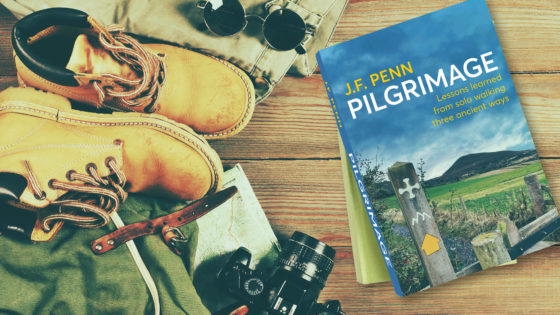
Longing for escape
The word ‘wanderlust’ means ‘a strong desire to travel,’ and I certainly have that! In 1983, when I was 8, my mum took us to live in Malawi, Africa (which I talked about in episode 1) and since then, travel has played an important part in my life. I presume it does for you, too, since you are listening to this!
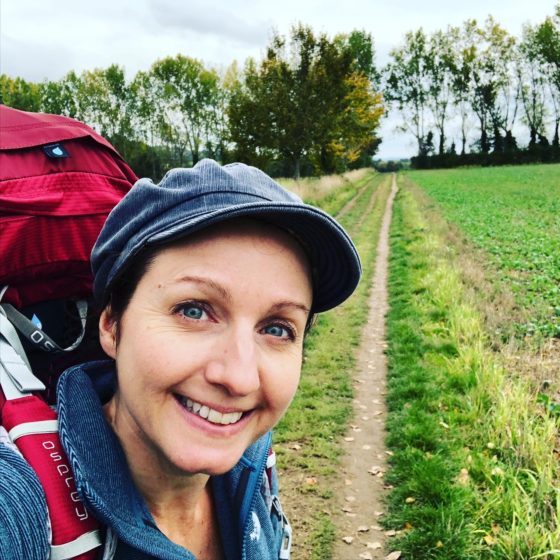
The last time I traveled was in February 2020 when Jonathan and I had a few days in Bilbao and San Sebastian, crushed into tiny pintxos bars sampling the local cuisine, wandering freely around the cities, walking through the Guggenheim with no thought of a mask. It seems like a different world now and my wanderlust has shifted into fernweh, a German word meaning ‘a longing for far off places.’ That longing goes deep and this time of enforced stillness intensified it so much that, at times, it spilled over into frustration and anger — at the world, at the virus, at myself, for not being able to quiet the need to get away.
I am safe and well and loved and busy, and able to work from home. I acknowledge my privilege and yet some days, I felt… still feel… like a bird banging its wings against the bars of a cage. I’m not an angry person, but when anger and frustration bubble up every day, I know I have to get moving. Walking every day has helped during the pandemic, but I have circled the local routes over and over, day after day, as the seasons changed.
During the summer, it seemed that perhaps there might be hope for an end and we had some glorious days in the sun — but then it became clear that the winter would be long and dark and it would be spring again before the beginning of the end of the pandemic. I needed a long walk for my mental health before the winter set in, and after weighing the risks, I decided to get out before the bars of my cage shut once more.
As I write this, a new strain is spreading across the UK. Countries have closed their borders to us and I couldn’t travel right now even if I wanted to. I am so glad I went when I did. I cannot control what is going on in the world, I can only control each step I take.
Walking long distance stills the mind and soothes the raging soul. It leaves you so tired at the end of the day that you can only shower, eat and sleep. The wider world matters little because you concentrate on the basics of life. You live in the moment. Every step is therapy. As Saint Augustine said, “Solvitur ambulando. It is solved by walking.”
I’m also a thriller writer and travel fuels my stories. I have always had an unending stream of ideas based on my sense of place. I finished Tree of Life, ARKANE #11 in mid-October and for the first time in my writing life, I had no places left to write about. My planned research trips had been cancelled and so this pilgrimage was also a way to inspire a story. I looked at my country with the eyes of an outsider, in the same way that I usually research foreign places. (Watch out for Day of the Martyr, coming in 2021!)
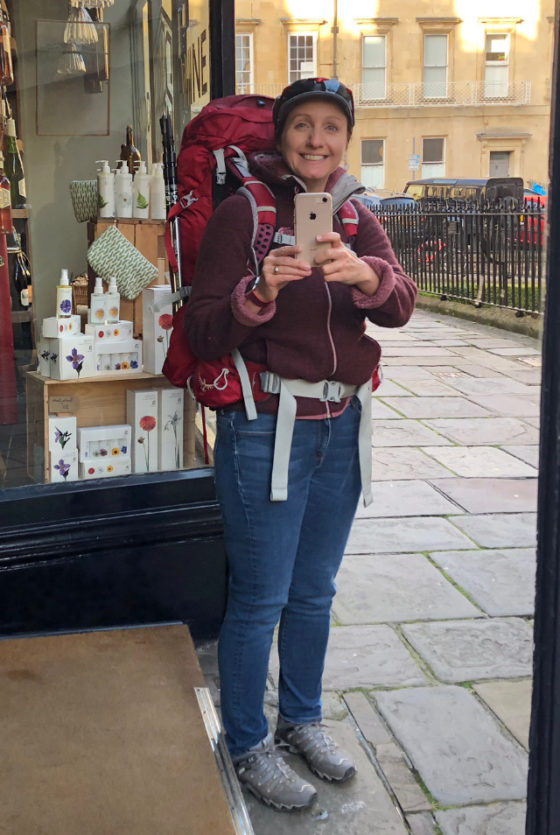
As I left the house that first morning, the solid weight of my backpack tight around my hips, I felt a quickening within. I was only leaving for a week, but it felt every bit as exciting as when I left London for Perth, Australia, in 2000. My backpack then contained all I owned, I had sold everything else and leaving was exquisite freedom. I didn’t know it when I walked away back then, but I started a new life and it would be 11 years until I moved back to London.
This time, I glimpsed that freedom even though I walked away from my wonderful husband who I would text within the hour and return to in a week, my cosy home, and work that I love. I didn’t need to start a new life, but I needed the respite.
When you stay shut up in your home as we have done for so much of this pandemic year, you experience much of the world through a screen and the skewed views of the media. Your world shrinks. Routine is death to my creative soul, and I was climbing the walls. I needed to escape.
Why pilgrimage?
“In each of us dwells a wanderer, a gypsy, a pilgrim… What matters most on your journey is how deeply you see, how attentively you hear, how richly the encounters are felt in your heart and soul.”
Phil Cousineau, The Art of Pilgrimage
The definition of a pilgrim is a person who ‘journeys to a sacred place for religious reasons,’ or ‘a person traveling to a place of particular personal interest,’ or ‘a person regarded as journeying through life.’ It is much more than just a long walk.
Pilgrimage is an outer journey toward a place that has personal meaning, but it’s also an inner exploration. It’s not a holiday. It’s meant to have some kind of hardship, but you get to determine the shape of that challenge.
Sacred places differ for everyone. I’m not a Catholic, so Thomas a Becket means nothing to me as a saint. I’m not a Christian, so pilgrimage is not a matter of faith. But I love religious history and architecture, which you’ll find in most of my novels in some form. I also consider myself spiritual in a sense.
We are part animal, part spirit, and a pilgrimage engages both sides. I know there is more than just a physical world and I’ve had experiences in many places where I have felt closer to the ineffable. Sometimes they are in natural settings and others are man-made. This journey had two particular moments that stand out.
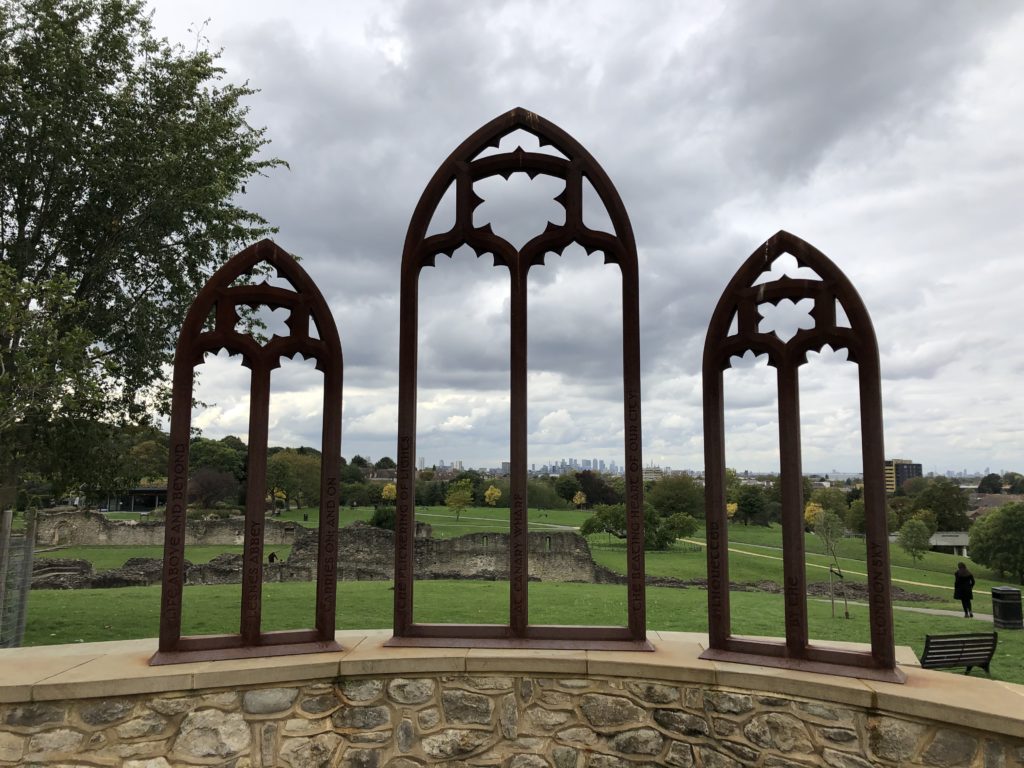
Near the end of the first day, exhausted after walking nearly forty kilometers, I found myself lost in the gritty urban streets of Erith. I walked through a noisy industrial estate — the roar of trucks and cranes, the scream of crushed metal, the shouts of men working. It was dirty and ugly with piles of rubbish for recycling, lumps of concrete and steel, broken appliances, mounds of discarded clothes. It smelled of spilled oil and the tang of metal, and the air was thick with dust. I was at my lowest ebb and I needed to hurry to make it to the hotel in Dartford. This was not an area I wanted to be in after dark.
Then I emerged onto the path at Crayford Ness, a tiny headland on the edge of the River Thames, an area of salt marsh unchanged for thousands of years because of the tidal flood plain. The industrial park comes within meters of the path in places, but if you stand with your back to the ugliness and ignore the noise, you can look back in time. Part of an ancient fossilized forest lies in these waters, dating back to the late Neolithic, five thousand years ago. The path winds alongside the River Darent and teems with bird life. The call of Canada geese honked overhead in the dusk, a heron stood motionless in the water, waiting to spear its prey, ducks and cormorants and oystercatchers waded and swam in the shallows. Skylarks trilled their song.
It was magical, perhaps all the more so for its juxtaposition to the ugliness of the industrial park and my emotional state before finding this pocket of sanctuary. No one comes to London to walk Crayford Ness to Dartford, but it was one of the most memorable parts of my pilgrimage.
I was alone walking the ancient salt marshes as the day turned to dusk and despite the encroachment of man, nature ruled. As it had done for millennia and as it will do when we are gone.
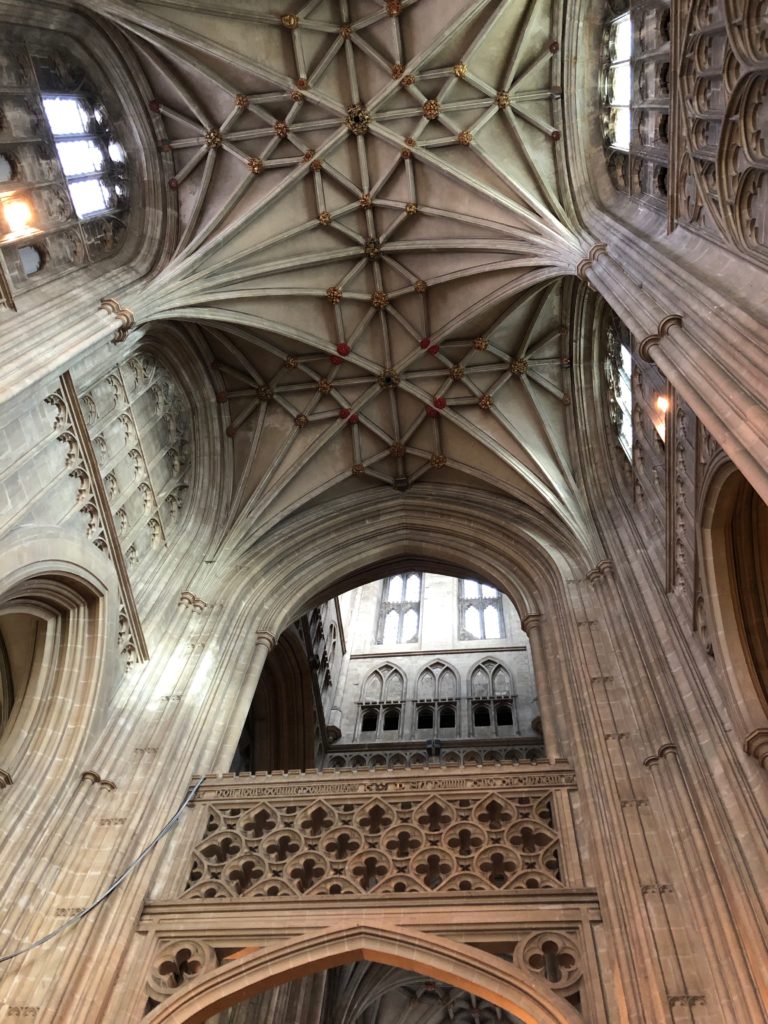
That hour was joy in nature, but I also felt a sense of wonder at Evensong in Canterbury Cathedral on the evening I finished my pilgrimage. I arrived about twenty minutes before the service and listened to the choir practice, and for most of that time, I sat alone in the nave. Men stood in their purple robes more than two meters apart on the steps to the quire.
They sang psalms in Latin, voices rising to the vault high above. Ancient stone, ancient faith, each note disappearing in a moment. I stayed for the service, but it was the practice before that truly moved me, those minutes alone in the cathedral nave that freed my spirit. A fitting end to my pilgrimage.
Transience and permanence
A part of my preparation for the pilgrimage, I wrote a series of questions to consider along the way: What am I escaping from? What is my challenge today? What do I need to reinvent? You can read the full list here.
I printed it out and stuck it in the front of my journal. Although I didn’t answer every question, every day, it helped frame the journey as an inner quest as well as an outer pilgrimage. I recommend The Art of Pilgrimage: The Seeker’s Guide to Making Travel Sacred by Phil Cousineau as a way to prompt your own questions.
I decided that the theme of my pilgrimage would be transience and permanence. It suited the pandemic year — the transience of life and the permanence of the earth I walked across. My passing was momentary, but pilgrims have walked the same way for over 800 years and will continue to walk for generations to come.
Death is close to all in this pandemic year, but I still find memento mori — remember you will die — to be a comforting thought, as I discussed with Loren Rhoads on our shared love for cemeteries, and with Dr. Karen Wyatt on how travel can help with grief. It gives each day renewed perspective when you consider how few we have on this earth and how important it is to make the most of each one. Here are just a few aspects of the pilgrimage that underscored this theme.
There are unusual cadaver tombs in both Southwark and Canterbury Cathedral, at the beginning and the end of the journey. These are rare depictions of the human body as a corpse as opposed to the grand effigies usually sitting above the tombs of nobility.
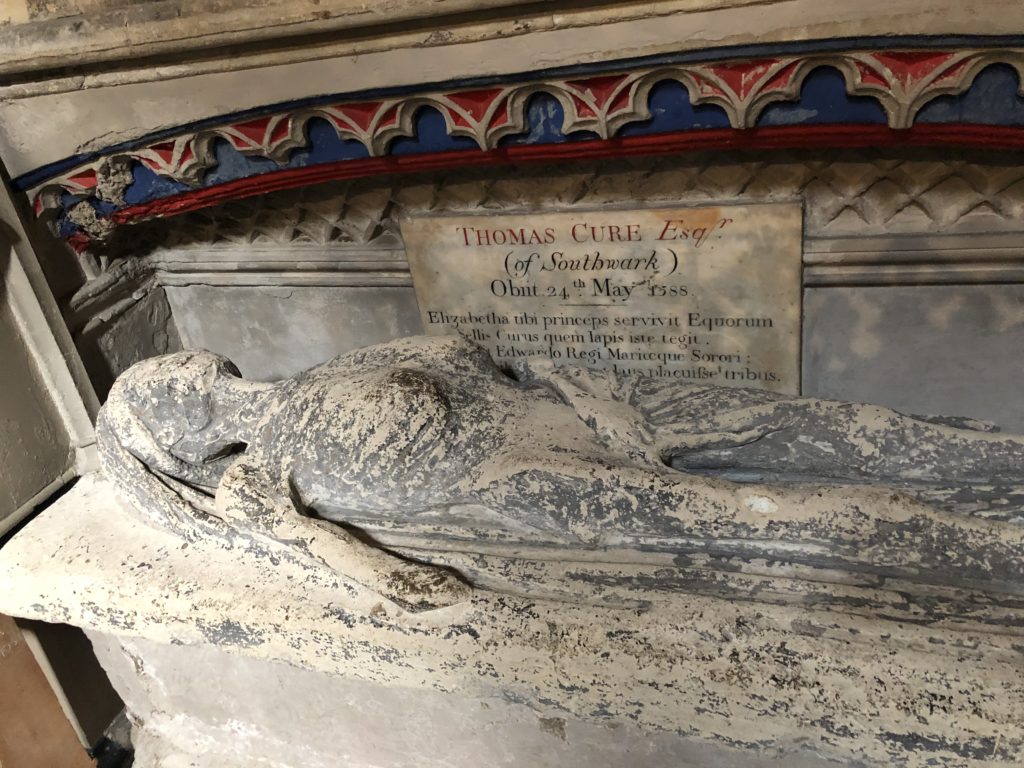
The Southwark cadaver is the medieval tomb of Thomas Cure who died in 1588, the same year as the Spanish Armada, during the reign of Elizabeth I. Its skeletal frame is weathered by time, its face disintegrated. It’s clearly a dead body, partially wrapped in a shroud, a simple representation of the inevitability of death.
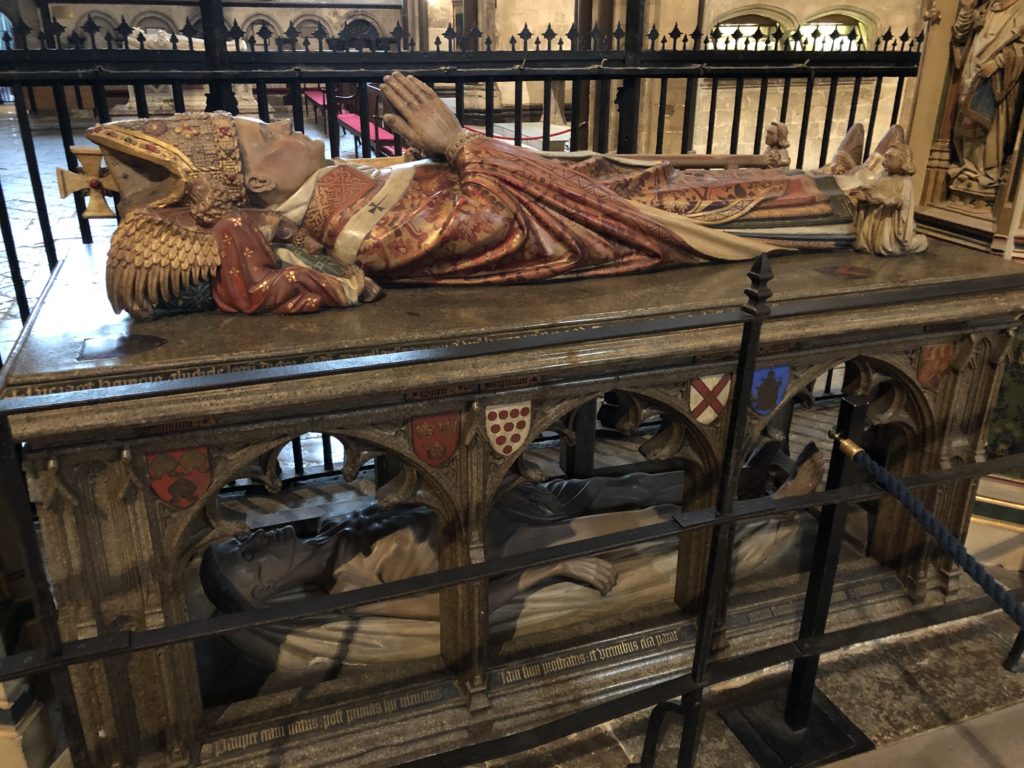
The Canterbury cadaver tomb is on an entirely different scale in terms of grandeur. The tomb of Archbishop Henry Chichele who died in 1443 has two levels, one showing the effigy of the man in full ecclesiastical robes and underneath, the cadaver stripped of all its finery, lying naked except for a shroud. It’s surrounded by an ornate decorated arch with figures from the church. A tour guide told me that the archbishop had the tomb built many years before his death so he could see it every day. Memento mori, indeed.
The transience of the natural world was in evidence as I walked every day. The golden light of autumn and leaves falling from the chestnut trees. Beech nuts and acorns on the muddy path. The last of the blackberries in the hedgerows, with rosehips and elderberries growing nearby. Rabbits ran through the fields and pheasants startled from the bushes, as the cry of a kite came from the cloudy sky above. The dying of one season as the world turns again. The cold bite of winter wind and the hope of spring ahead.
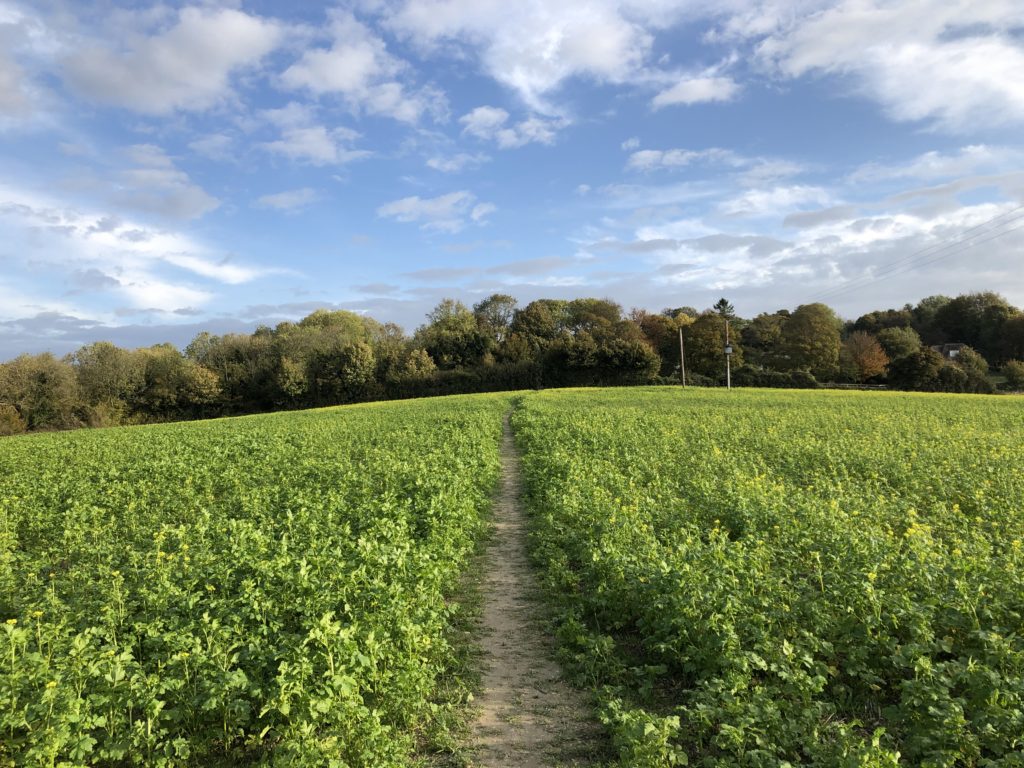
Then there were the transient sensations and emotions of the internal world. Sometimes the map looked huge, the distances enormous, my will diminished and my body weak. I felt bruised and broken and ugly. At other times, the kilometers disappeared under my feet, my spirit soaring, a smile on my face, my body strong and well and beautiful.
At times, my feelings distorted the world, and at others, the world changed me. The physical pain and my internal feelings were transient — I could only capture them in writing each day, because now all I feel is the permanence of accomplishment. I finished the pilgrimage, and what I felt along the way is just a fading memory.
“Stranger, pass by that which you do not love.”
This old pilgrim advice by an anonymous sage sticks with me, because while parts of the way were beautiful, I did not love the long stretches of open paths across fields and through woods. I needed them for the respite from thinking — but I love the Gothic cathedrals more. The soaring nave, the arches and vaults, the lines of clean stone. That stark beauty takes me out of myself and catches my imagination so much more.
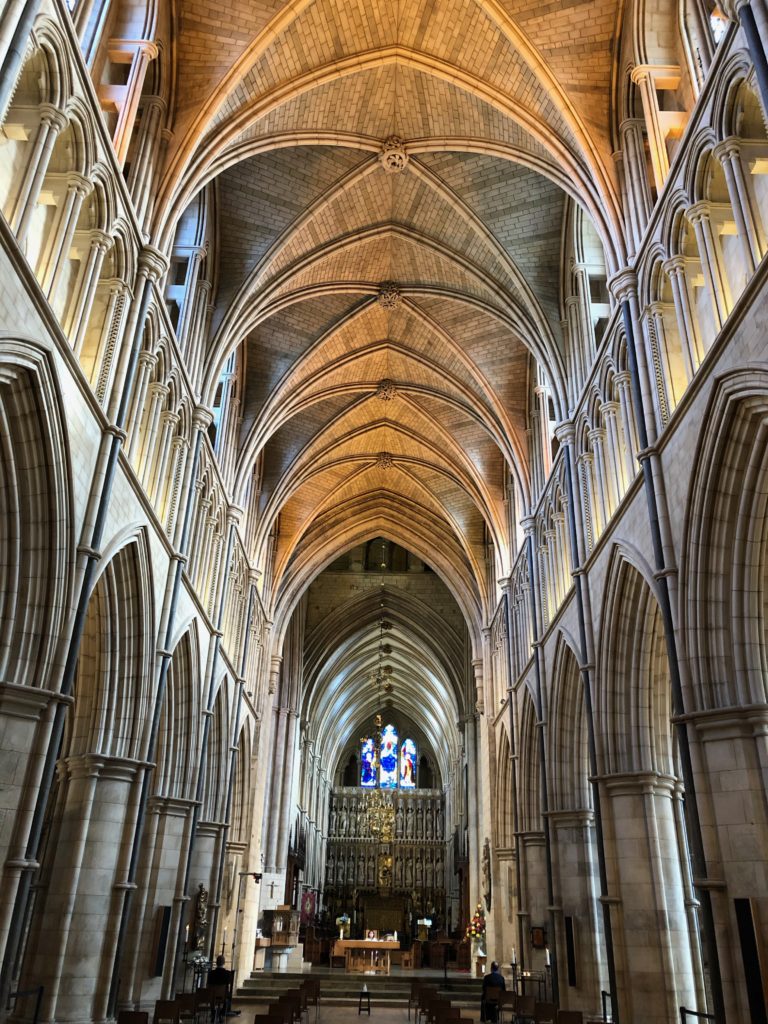
The Pilgrims’ Way out of London is not a pretty walk for several of the days. It is a journey through history, rather than a natural escape. Much of it is through urban landscapes, and even in the countryside, you are within earshot of busy roads.
Some walking routes are about natural beauty. This one is mainly about the human environment. In a thousand years of history, life is rarely pretty. But humans are animals, humans are nature, and I love the places where we have made our mark over generations.
Pushing the boundaries of your comfort zone
One of the key aspects of a pilgrimage is some kind of challenge or hardship to overcome. This is inherently personal, and everyone will have their own definition.
I’ve done a lot of hiking over the years, but I’ve never walked and navigated a multi-day solo trip carrying all my gear. I’ve certainly never traveled during a pandemic. So I had a few fears to tackle, and I definitely pushed the boundaries of my comfort zone.
Fear of getting lost
In order to mitigate this, I did a day’s National Navigation Award Scheme (NNAS) navigation training a few weeks before leaving in order to refresh my rusty map reading skills. I planned my route on physical OS Maps and cut them up so I could carry each segment in my waterproof map-holder every day.
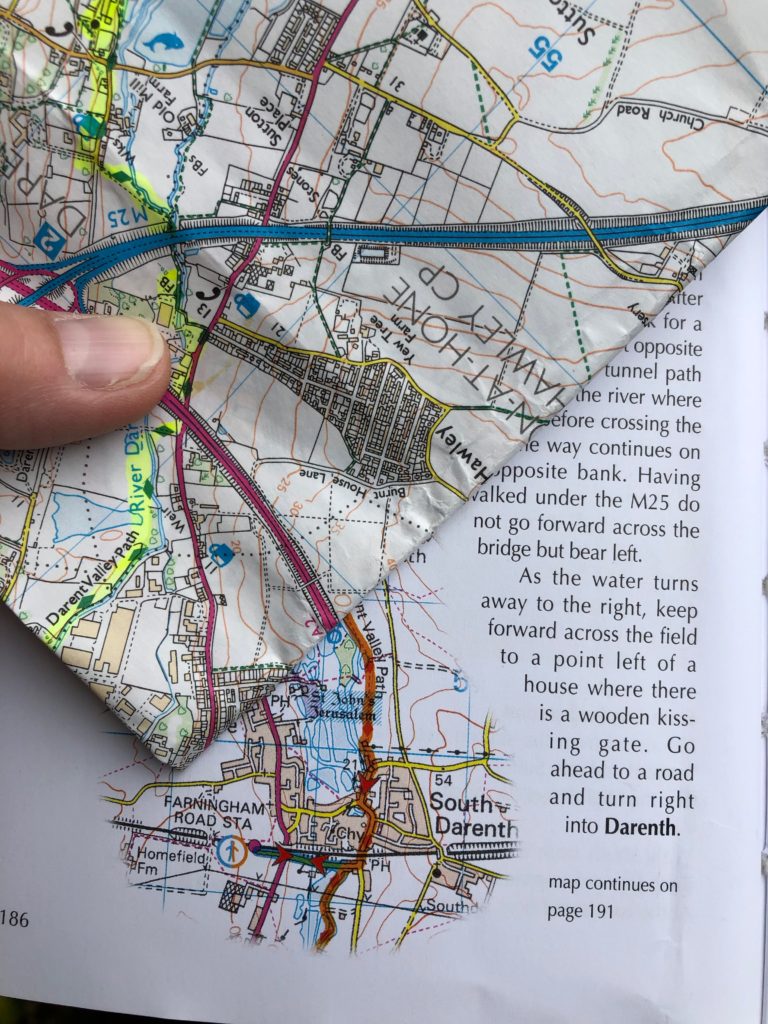
I also carried the guidebook to the route and my mobile phone with Google Maps and the OS Maps app and a spare battery. I had to use my phone at several points, particularly in urban built-up areas when it was harder to navigate the physical map due to scale.
I got lost a few times. At one point, I ended up wandering around a strawberry farm until I found a tiny path at the side of a hedge, and I walked through some gritty housing estates unnecessarily on the outskirts of London. But it wasn’t that bad, and it all became part of the challenge.
The Pilgrims’ Way is a very good route for a novice navigator and a first solo multi-day walk. Much of the way is on established paths, the Green Chain in London, then the North Downs Way in Kent. You are never far from civilization, so you don’t need to carry anything more than basic supplies. There are coffee shops, cafes and pubs along the route and plenty of B&Bs and hotels so you don’t need to camp.
I found navigation to be a kind of magic, preferring the physical OS Maps to the guidebook. Lines and symbols on the page turn into the richness of real life as you move across the world. Life ticks away and it’s hard to measure, but you can quantify lines on a map and kilometers walked. You can plan according to those lines, but as the day passes, experience and emotion overlay them with depth.
The symbols look the same on the map, for example, a cross representing a church, but each was different in the real world.
Boxley Church was alive in the morning sun with violets growing over graves in the dappled light and harvest gourds offered in a box at the lych-gate. I was the only person there that morning but it felt warm and alive with faith and I lingered taking photos of gravestones in the sun.
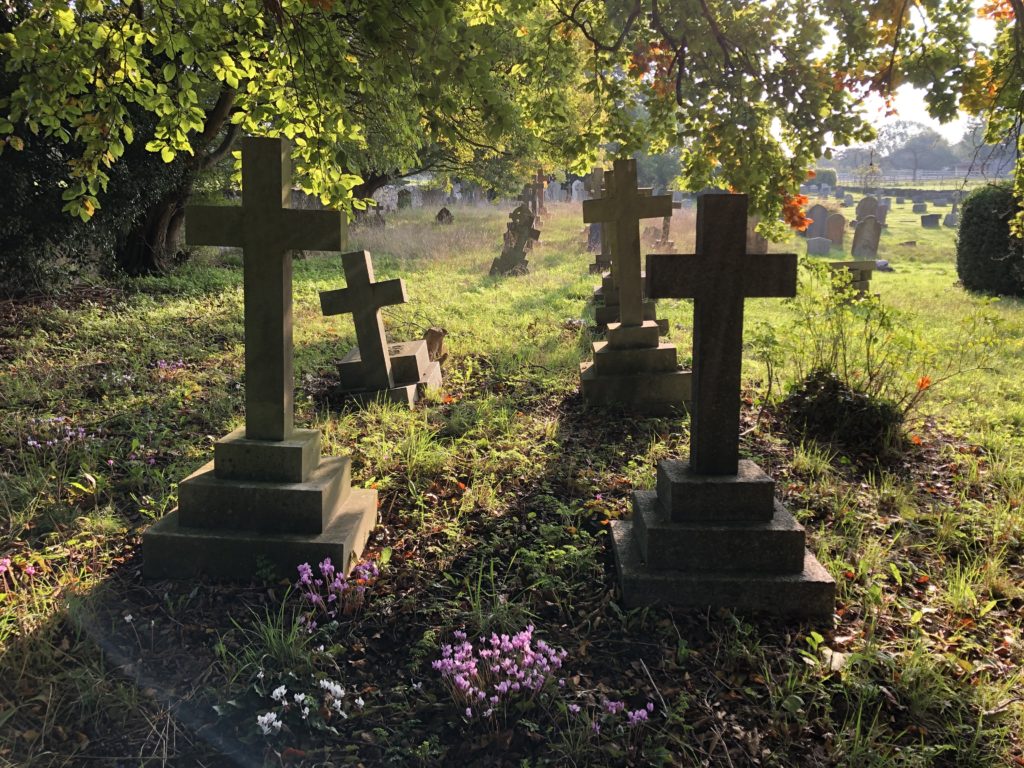
Later that day, I walked past the 12th-century church of St Mary the Virgin at Thurnham, its doors barred up, its churchyard desolate. It felt cold and empty, and I walked on quickly. The symbols looked the same on the map, but the churches were quite opposite in how they touched my spirit.
Fear of other people
As I shared my pictures on Instagram (@jfpennauthor) each day, several women asked whether I was anxious walking alone or whether I was scared of being attacked. It is a valid concern but it’s not something I worried about.
I was alone most of the time outside of urban areas, and the only people I saw were dog-walkers or fellow hikers, friendly people who love their solitude as much as I do. We nodded or said hello, but there wasn’t much interaction on the way, and as an introvert, I’m happy with that.
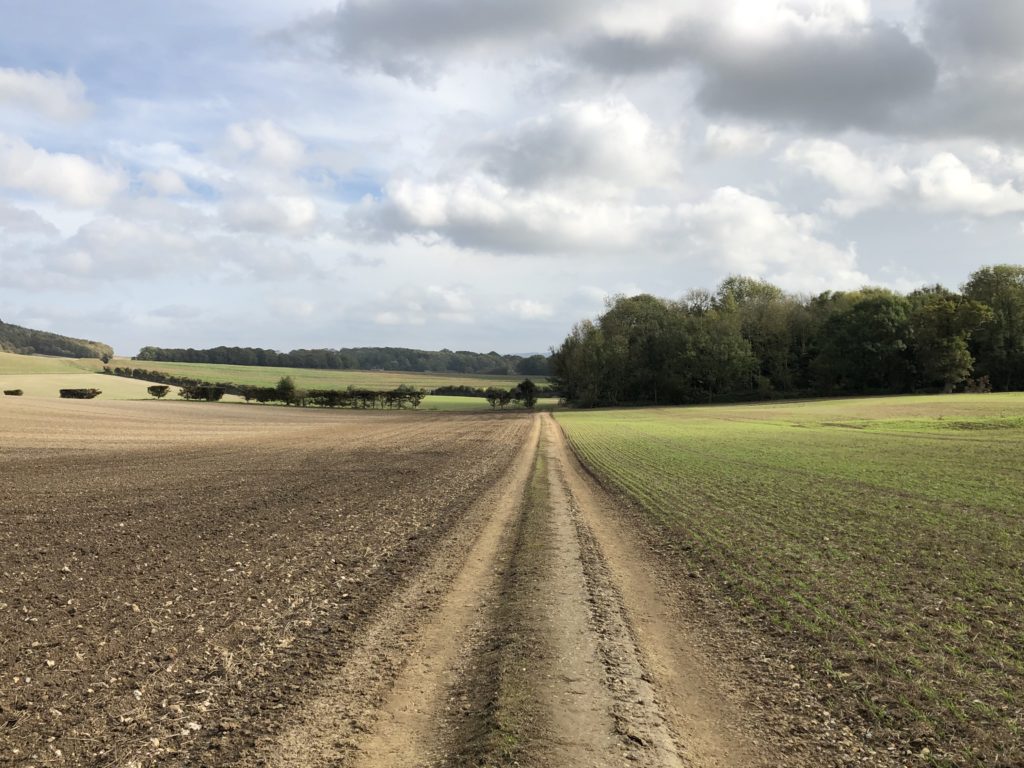
I enjoy walking alone. I can stop when I want, take pictures, have a rest, have a wee in a bush! I can walk at my own pace and think about things. I don’t have to talk to anyone. If I had been with Jonathan or a friend or a group, I would probably have moaned in those moments when I struggled. I would have let someone else navigate. By walking alone, I just gave myself a talking to, ate something, maybe had a cry, before walking on.
The media stoke fear of others, but in my travels over the years, much of it alone, I have rarely felt unsafe. People are mostly good and will help you, rather than harm you, as you would help someone in need.
But of course, I am cautious and sensible. I was inside my hotel each night before dark. I planned my itinerary in advance and my husband and my mum had copies. My mobile phone tracks where I am and I checked in regularly.
I also walk with confidence, even with a pack on. My hard-working single mum drilled this into me early, because I would walk home alone from school. She also took me and my brother to martial arts classes where the instructor taught us to walk like a tiger, walk like a predator, not like prey.
I’ve had my share of difficult encounters, but they have usually been in bars and other urban settings and not out walking in the sun and the wind and the rain.
However, there is danger on the route from other people in cars on the roads. There are a couple of places where you have to walk on sections with limited visibility, especially at dawn or dusk. Walk into the traffic on the right-hand side of the road so you can see cars coming and make sure they see you. Wear a head torch and reflective gear and stay safe.
Fear of pain, illness — and disease
While I wasn’t afraid of other people physically harming me, I was out walking during a pandemic. I had some reservations about going, but my risk profile as a healthy 45-year-old woman with no underlying conditions was very low. I was outside most of the time on my own in the fresh air, and when I went into a shop or cafe or hotel/B&B, I followed all the guidelines around wearing a mask, sanitizing, hand-washing, and social distancing.
For most of the days, I saw so few people that I could have forgotten the pandemic even existed, and that was a relief in itself.
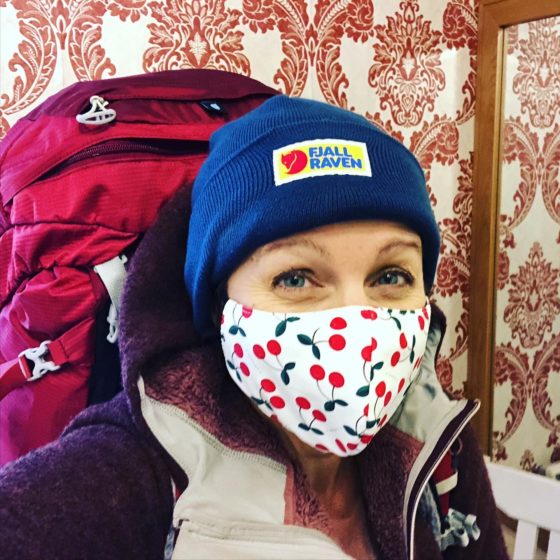
I was also apprehensive about the possible physical pain of walking for six days in a row, with a schedule I had to meet as I pre-booked accommodation every night and had to travel 25-45 kilometers per day. I have done several ultra-marathon walks, with 50 km in one day, and 100 km in a weekend and I’ve done longer multi-day trips with days off in the middle, so I am experienced in some ways. But I hadn’t carried my bigger pack for an entire trip, and I had not done six days in a row before. I was also alone, so what if I fell and injured myself? What if I had terrible blisters and couldn’t walk?
These fears turned out to be unfounded because I was well prepared. I didn’t fall because I used walking poles on the days when the ground was muddy or it poured with rain, or if I was feeling tired and a bit wobbly. I had some inevitable muscular pain but a couple of ibuprofen with my coffee in the morning dealt with that and after a few kilometers, everything warmed up. Some aches can be walked away.
Every morning, I pressed my bare feet, looking for sore spots to stop any blisters early — I only had a tiny one on my little toe by the end. I put talcum powder in my socks and changed them twice a day, which makes a huge difference. Look after your feet is probably the number one rule of walking longer distances!
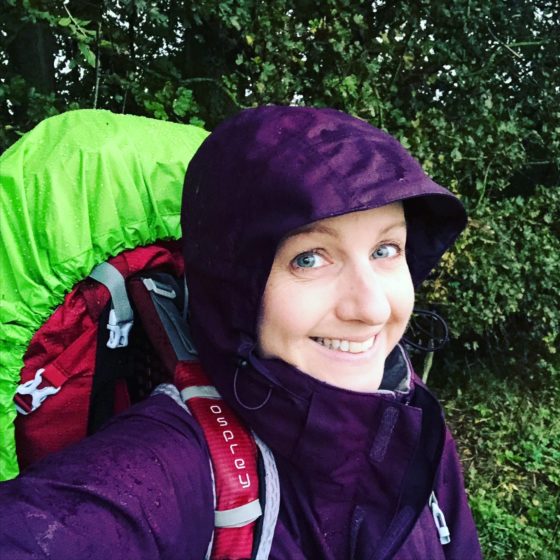
On the last day, it rained heavily for hours. Despite my waterproof gear and even waterproof socks, everything got wet and cold. I wanted it to be over, and the walk seemed to go on forever. At one point, I almost fell in the mud on a steep hill.
As my heart raced with the adrenalin of catching myself with my poles just in time, I looked out over the North Downs in the pouring rain — Don’t wish the time away. Make the most of this freedom while you can. It will be over soon enough and you will wish you were back out here.
Give it time to settle
No one will pat you on the back at the end of your pilgrimage. There is no fanfare. You can seek a blessing in the cathedral, but I had the beauty of Evensong and that was enough for me.
On the day after finishing, I lay in bed, drained and exhausted. My feet and legs ached. I had a lot of random bruises. I felt beaten up and tearful. There was no sense of elation or triumph, only an unexpected emptiness. I was disappointed that I had not come away with some huge insight into life. I had expected to find answers, but instead, my journal was filled with the practicalities of walking, glimpses of the physical landscape, and disjointed fragments of emotion.
Of course, 182 km / 113 miles in six days will inevitably leave you tired and pilgrimage is meant to be a challenge. The walk was physically tiring, but also mentally draining to navigate. Tiredness can skew everything black, and my only remedy is sleep.
I didn’t go home that day. I returned to the cathedral as a tourist, whereas the night before, I had visited as a pilgrim. I was gentle with myself and took the time to settle back into life before I returned home. As an introvert, happy to be alone, I had barely spoken to anyone for almost a week. I took a day to re-enter the real world. My physical body recovered quickly, but the lessons of a pilgrimage need time to settle.

The trip was a walking meditation, a welcome respite from the monotony of the pandemic year. After talking to Holly Worton about multi-day walks in episode 42, I had decided before I left to write some kind of travel memoir and trip guide to the Pilgrims’ Way. But I know what it takes to write a book, and I did not have enough for that.
People asked me about the trip, and I brushed off their inquiries. While it quietened my fernweh and helped my mental health, especially as we entered a second lockdown soon after my return, it did not give me what I thought I wanted.
Now, two months later, I realize that my pilgrimage gave me far more than I thought at the time.
The mental break gave me the rest I needed to leap into what I consider some of my best work, perhaps in years. I’ve been able to articulate what I want to focus on for my next creative project. I know my direction for the next decade. I also published three books in the months following the trip, two of them completely unexpected.
Sometimes we don’t need to think, we just need to move and the thoughts will come later.
The next step
There is a stone marker outside Canterbury Cathedral for the Via Francigena, which runs from Canterbury to Rome. It’s around 1700 km and takes a few months to walk. As I left to come home that final morning, I must admit to a moment of longing to set off again!
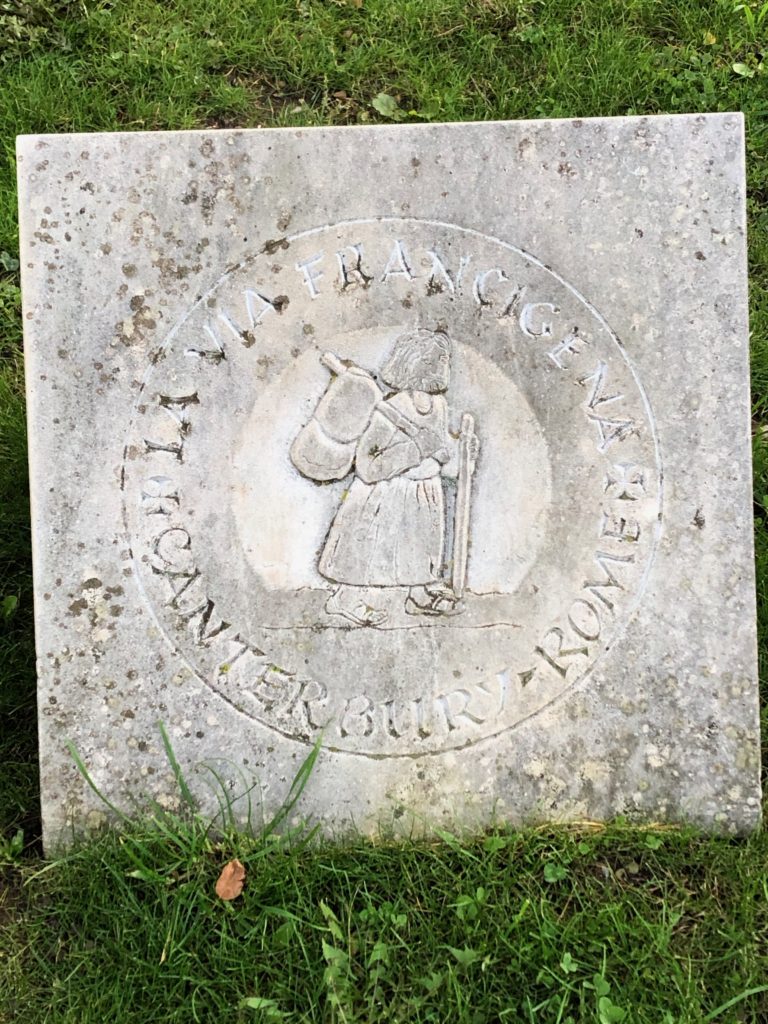
Pilgrimages combine my love of longer-distance walking with the chance to see incredible places built by faith over millennia, so I will definitely do more, especially since I now recognize the creative benefits.
I have wanted to do the Camino de Santiago, particularly the Frances route, for many years, as I have mentioned on this podcast several times! But now I think I’d like to do one of the lesser-known ways, so I’m researching options.
In the meantime, I’m considering the St Cuthbert’s Way so I can visit the holy island of Lindisfarne, which I wrote about in Day of the Vikings, but have never seen. Given that the pandemic travel restrictions are likely to continue, I’ll explore UK options before planning other trips.
In conclusion, walking the Pilgrims’ Way gave me respite and refreshment in pandemic times, it expanded my comfort zone and gave me renewed confidence in what I can physically achieve.
It also opened up new horizons in my creative and writing life — not in the direction that I had expected, but perhaps that is always the reality of such a journey.
“The end of our explorations will be to arrive where we started and know the place for the first time.” T. S. Eliot
The post This Too Shall Pass. Thoughts From The Pilgrims’ Way With J.F. Penn appeared first on Books And Travel.
92 episodes
Manage episode 281104552 series 2496001
“Man’s real home is not a house, but the Road, and that life itself is a journey to be walked on foot.” Bruce Chatwin
In late October 2020, I walked the Pilgrims’ Way from Southwark Cathedral in London to Canterbury Cathedral in Kent, 182 km/113 miles on foot, alone, carrying my own gear… during a global pandemic.
A Roman road 2000 years ago, the route became popular for pilgrims after the martyrdom of St Thomas a Becket on 29 December 1170 at the hands of four knights of King Henry II. In literature, The Canterbury Tales by Geoffrey Chaucer follows a cast of colorful pilgrims on the way, and T. S. Eliot’s Murder in the Cathedral dramatically captures the archbishop’s bloody end.
In this episode, published on the 850th anniversary of the martyrdom, I’ll share the personal side of my journey. I’ve written separately about the practical side of the pilgrimage with day by day photos here.
- Fernweh. Longing for escape.
- Why pilgrimage?
- Transience and permanence. Questions I asked myself on the way.
- “Stranger, pass by that which you do not love.”
- Pushing the boundaries of your comfort zone and tackling fear
- Give it time to settle. The lessons of pilgrimage may not be immediately obvious.
- The next step
My book, Pilgrimage, Lessons Learned from Solo Walking Three Ancient Ways, featuring the Pilgrims’ Way is out now.

Longing for escape
The word ‘wanderlust’ means ‘a strong desire to travel,’ and I certainly have that! In 1983, when I was 8, my mum took us to live in Malawi, Africa (which I talked about in episode 1) and since then, travel has played an important part in my life. I presume it does for you, too, since you are listening to this!

The last time I traveled was in February 2020 when Jonathan and I had a few days in Bilbao and San Sebastian, crushed into tiny pintxos bars sampling the local cuisine, wandering freely around the cities, walking through the Guggenheim with no thought of a mask. It seems like a different world now and my wanderlust has shifted into fernweh, a German word meaning ‘a longing for far off places.’ That longing goes deep and this time of enforced stillness intensified it so much that, at times, it spilled over into frustration and anger — at the world, at the virus, at myself, for not being able to quiet the need to get away.
I am safe and well and loved and busy, and able to work from home. I acknowledge my privilege and yet some days, I felt… still feel… like a bird banging its wings against the bars of a cage. I’m not an angry person, but when anger and frustration bubble up every day, I know I have to get moving. Walking every day has helped during the pandemic, but I have circled the local routes over and over, day after day, as the seasons changed.
During the summer, it seemed that perhaps there might be hope for an end and we had some glorious days in the sun — but then it became clear that the winter would be long and dark and it would be spring again before the beginning of the end of the pandemic. I needed a long walk for my mental health before the winter set in, and after weighing the risks, I decided to get out before the bars of my cage shut once more.
As I write this, a new strain is spreading across the UK. Countries have closed their borders to us and I couldn’t travel right now even if I wanted to. I am so glad I went when I did. I cannot control what is going on in the world, I can only control each step I take.
Walking long distance stills the mind and soothes the raging soul. It leaves you so tired at the end of the day that you can only shower, eat and sleep. The wider world matters little because you concentrate on the basics of life. You live in the moment. Every step is therapy. As Saint Augustine said, “Solvitur ambulando. It is solved by walking.”
I’m also a thriller writer and travel fuels my stories. I have always had an unending stream of ideas based on my sense of place. I finished Tree of Life, ARKANE #11 in mid-October and for the first time in my writing life, I had no places left to write about. My planned research trips had been cancelled and so this pilgrimage was also a way to inspire a story. I looked at my country with the eyes of an outsider, in the same way that I usually research foreign places. (Watch out for Day of the Martyr, coming in 2021!)

As I left the house that first morning, the solid weight of my backpack tight around my hips, I felt a quickening within. I was only leaving for a week, but it felt every bit as exciting as when I left London for Perth, Australia, in 2000. My backpack then contained all I owned, I had sold everything else and leaving was exquisite freedom. I didn’t know it when I walked away back then, but I started a new life and it would be 11 years until I moved back to London.
This time, I glimpsed that freedom even though I walked away from my wonderful husband who I would text within the hour and return to in a week, my cosy home, and work that I love. I didn’t need to start a new life, but I needed the respite.
When you stay shut up in your home as we have done for so much of this pandemic year, you experience much of the world through a screen and the skewed views of the media. Your world shrinks. Routine is death to my creative soul, and I was climbing the walls. I needed to escape.
Why pilgrimage?
“In each of us dwells a wanderer, a gypsy, a pilgrim… What matters most on your journey is how deeply you see, how attentively you hear, how richly the encounters are felt in your heart and soul.”
Phil Cousineau, The Art of Pilgrimage
The definition of a pilgrim is a person who ‘journeys to a sacred place for religious reasons,’ or ‘a person traveling to a place of particular personal interest,’ or ‘a person regarded as journeying through life.’ It is much more than just a long walk.
Pilgrimage is an outer journey toward a place that has personal meaning, but it’s also an inner exploration. It’s not a holiday. It’s meant to have some kind of hardship, but you get to determine the shape of that challenge.
Sacred places differ for everyone. I’m not a Catholic, so Thomas a Becket means nothing to me as a saint. I’m not a Christian, so pilgrimage is not a matter of faith. But I love religious history and architecture, which you’ll find in most of my novels in some form. I also consider myself spiritual in a sense.
We are part animal, part spirit, and a pilgrimage engages both sides. I know there is more than just a physical world and I’ve had experiences in many places where I have felt closer to the ineffable. Sometimes they are in natural settings and others are man-made. This journey had two particular moments that stand out.

Near the end of the first day, exhausted after walking nearly forty kilometers, I found myself lost in the gritty urban streets of Erith. I walked through a noisy industrial estate — the roar of trucks and cranes, the scream of crushed metal, the shouts of men working. It was dirty and ugly with piles of rubbish for recycling, lumps of concrete and steel, broken appliances, mounds of discarded clothes. It smelled of spilled oil and the tang of metal, and the air was thick with dust. I was at my lowest ebb and I needed to hurry to make it to the hotel in Dartford. This was not an area I wanted to be in after dark.
Then I emerged onto the path at Crayford Ness, a tiny headland on the edge of the River Thames, an area of salt marsh unchanged for thousands of years because of the tidal flood plain. The industrial park comes within meters of the path in places, but if you stand with your back to the ugliness and ignore the noise, you can look back in time. Part of an ancient fossilized forest lies in these waters, dating back to the late Neolithic, five thousand years ago. The path winds alongside the River Darent and teems with bird life. The call of Canada geese honked overhead in the dusk, a heron stood motionless in the water, waiting to spear its prey, ducks and cormorants and oystercatchers waded and swam in the shallows. Skylarks trilled their song.
It was magical, perhaps all the more so for its juxtaposition to the ugliness of the industrial park and my emotional state before finding this pocket of sanctuary. No one comes to London to walk Crayford Ness to Dartford, but it was one of the most memorable parts of my pilgrimage.
I was alone walking the ancient salt marshes as the day turned to dusk and despite the encroachment of man, nature ruled. As it had done for millennia and as it will do when we are gone.

That hour was joy in nature, but I also felt a sense of wonder at Evensong in Canterbury Cathedral on the evening I finished my pilgrimage. I arrived about twenty minutes before the service and listened to the choir practice, and for most of that time, I sat alone in the nave. Men stood in their purple robes more than two meters apart on the steps to the quire.
They sang psalms in Latin, voices rising to the vault high above. Ancient stone, ancient faith, each note disappearing in a moment. I stayed for the service, but it was the practice before that truly moved me, those minutes alone in the cathedral nave that freed my spirit. A fitting end to my pilgrimage.
Transience and permanence
A part of my preparation for the pilgrimage, I wrote a series of questions to consider along the way: What am I escaping from? What is my challenge today? What do I need to reinvent? You can read the full list here.
I printed it out and stuck it in the front of my journal. Although I didn’t answer every question, every day, it helped frame the journey as an inner quest as well as an outer pilgrimage. I recommend The Art of Pilgrimage: The Seeker’s Guide to Making Travel Sacred by Phil Cousineau as a way to prompt your own questions.
I decided that the theme of my pilgrimage would be transience and permanence. It suited the pandemic year — the transience of life and the permanence of the earth I walked across. My passing was momentary, but pilgrims have walked the same way for over 800 years and will continue to walk for generations to come.
Death is close to all in this pandemic year, but I still find memento mori — remember you will die — to be a comforting thought, as I discussed with Loren Rhoads on our shared love for cemeteries, and with Dr. Karen Wyatt on how travel can help with grief. It gives each day renewed perspective when you consider how few we have on this earth and how important it is to make the most of each one. Here are just a few aspects of the pilgrimage that underscored this theme.
There are unusual cadaver tombs in both Southwark and Canterbury Cathedral, at the beginning and the end of the journey. These are rare depictions of the human body as a corpse as opposed to the grand effigies usually sitting above the tombs of nobility.

The Southwark cadaver is the medieval tomb of Thomas Cure who died in 1588, the same year as the Spanish Armada, during the reign of Elizabeth I. Its skeletal frame is weathered by time, its face disintegrated. It’s clearly a dead body, partially wrapped in a shroud, a simple representation of the inevitability of death.

The Canterbury cadaver tomb is on an entirely different scale in terms of grandeur. The tomb of Archbishop Henry Chichele who died in 1443 has two levels, one showing the effigy of the man in full ecclesiastical robes and underneath, the cadaver stripped of all its finery, lying naked except for a shroud. It’s surrounded by an ornate decorated arch with figures from the church. A tour guide told me that the archbishop had the tomb built many years before his death so he could see it every day. Memento mori, indeed.
The transience of the natural world was in evidence as I walked every day. The golden light of autumn and leaves falling from the chestnut trees. Beech nuts and acorns on the muddy path. The last of the blackberries in the hedgerows, with rosehips and elderberries growing nearby. Rabbits ran through the fields and pheasants startled from the bushes, as the cry of a kite came from the cloudy sky above. The dying of one season as the world turns again. The cold bite of winter wind and the hope of spring ahead.

Then there were the transient sensations and emotions of the internal world. Sometimes the map looked huge, the distances enormous, my will diminished and my body weak. I felt bruised and broken and ugly. At other times, the kilometers disappeared under my feet, my spirit soaring, a smile on my face, my body strong and well and beautiful.
At times, my feelings distorted the world, and at others, the world changed me. The physical pain and my internal feelings were transient — I could only capture them in writing each day, because now all I feel is the permanence of accomplishment. I finished the pilgrimage, and what I felt along the way is just a fading memory.
“Stranger, pass by that which you do not love.”
This old pilgrim advice by an anonymous sage sticks with me, because while parts of the way were beautiful, I did not love the long stretches of open paths across fields and through woods. I needed them for the respite from thinking — but I love the Gothic cathedrals more. The soaring nave, the arches and vaults, the lines of clean stone. That stark beauty takes me out of myself and catches my imagination so much more.

The Pilgrims’ Way out of London is not a pretty walk for several of the days. It is a journey through history, rather than a natural escape. Much of it is through urban landscapes, and even in the countryside, you are within earshot of busy roads.
Some walking routes are about natural beauty. This one is mainly about the human environment. In a thousand years of history, life is rarely pretty. But humans are animals, humans are nature, and I love the places where we have made our mark over generations.
Pushing the boundaries of your comfort zone
One of the key aspects of a pilgrimage is some kind of challenge or hardship to overcome. This is inherently personal, and everyone will have their own definition.
I’ve done a lot of hiking over the years, but I’ve never walked and navigated a multi-day solo trip carrying all my gear. I’ve certainly never traveled during a pandemic. So I had a few fears to tackle, and I definitely pushed the boundaries of my comfort zone.
Fear of getting lost
In order to mitigate this, I did a day’s National Navigation Award Scheme (NNAS) navigation training a few weeks before leaving in order to refresh my rusty map reading skills. I planned my route on physical OS Maps and cut them up so I could carry each segment in my waterproof map-holder every day.

I also carried the guidebook to the route and my mobile phone with Google Maps and the OS Maps app and a spare battery. I had to use my phone at several points, particularly in urban built-up areas when it was harder to navigate the physical map due to scale.
I got lost a few times. At one point, I ended up wandering around a strawberry farm until I found a tiny path at the side of a hedge, and I walked through some gritty housing estates unnecessarily on the outskirts of London. But it wasn’t that bad, and it all became part of the challenge.
The Pilgrims’ Way is a very good route for a novice navigator and a first solo multi-day walk. Much of the way is on established paths, the Green Chain in London, then the North Downs Way in Kent. You are never far from civilization, so you don’t need to carry anything more than basic supplies. There are coffee shops, cafes and pubs along the route and plenty of B&Bs and hotels so you don’t need to camp.
I found navigation to be a kind of magic, preferring the physical OS Maps to the guidebook. Lines and symbols on the page turn into the richness of real life as you move across the world. Life ticks away and it’s hard to measure, but you can quantify lines on a map and kilometers walked. You can plan according to those lines, but as the day passes, experience and emotion overlay them with depth.
The symbols look the same on the map, for example, a cross representing a church, but each was different in the real world.
Boxley Church was alive in the morning sun with violets growing over graves in the dappled light and harvest gourds offered in a box at the lych-gate. I was the only person there that morning but it felt warm and alive with faith and I lingered taking photos of gravestones in the sun.

Later that day, I walked past the 12th-century church of St Mary the Virgin at Thurnham, its doors barred up, its churchyard desolate. It felt cold and empty, and I walked on quickly. The symbols looked the same on the map, but the churches were quite opposite in how they touched my spirit.
Fear of other people
As I shared my pictures on Instagram (@jfpennauthor) each day, several women asked whether I was anxious walking alone or whether I was scared of being attacked. It is a valid concern but it’s not something I worried about.
I was alone most of the time outside of urban areas, and the only people I saw were dog-walkers or fellow hikers, friendly people who love their solitude as much as I do. We nodded or said hello, but there wasn’t much interaction on the way, and as an introvert, I’m happy with that.

I enjoy walking alone. I can stop when I want, take pictures, have a rest, have a wee in a bush! I can walk at my own pace and think about things. I don’t have to talk to anyone. If I had been with Jonathan or a friend or a group, I would probably have moaned in those moments when I struggled. I would have let someone else navigate. By walking alone, I just gave myself a talking to, ate something, maybe had a cry, before walking on.
The media stoke fear of others, but in my travels over the years, much of it alone, I have rarely felt unsafe. People are mostly good and will help you, rather than harm you, as you would help someone in need.
But of course, I am cautious and sensible. I was inside my hotel each night before dark. I planned my itinerary in advance and my husband and my mum had copies. My mobile phone tracks where I am and I checked in regularly.
I also walk with confidence, even with a pack on. My hard-working single mum drilled this into me early, because I would walk home alone from school. She also took me and my brother to martial arts classes where the instructor taught us to walk like a tiger, walk like a predator, not like prey.
I’ve had my share of difficult encounters, but they have usually been in bars and other urban settings and not out walking in the sun and the wind and the rain.
However, there is danger on the route from other people in cars on the roads. There are a couple of places where you have to walk on sections with limited visibility, especially at dawn or dusk. Walk into the traffic on the right-hand side of the road so you can see cars coming and make sure they see you. Wear a head torch and reflective gear and stay safe.
Fear of pain, illness — and disease
While I wasn’t afraid of other people physically harming me, I was out walking during a pandemic. I had some reservations about going, but my risk profile as a healthy 45-year-old woman with no underlying conditions was very low. I was outside most of the time on my own in the fresh air, and when I went into a shop or cafe or hotel/B&B, I followed all the guidelines around wearing a mask, sanitizing, hand-washing, and social distancing.
For most of the days, I saw so few people that I could have forgotten the pandemic even existed, and that was a relief in itself.

I was also apprehensive about the possible physical pain of walking for six days in a row, with a schedule I had to meet as I pre-booked accommodation every night and had to travel 25-45 kilometers per day. I have done several ultra-marathon walks, with 50 km in one day, and 100 km in a weekend and I’ve done longer multi-day trips with days off in the middle, so I am experienced in some ways. But I hadn’t carried my bigger pack for an entire trip, and I had not done six days in a row before. I was also alone, so what if I fell and injured myself? What if I had terrible blisters and couldn’t walk?
These fears turned out to be unfounded because I was well prepared. I didn’t fall because I used walking poles on the days when the ground was muddy or it poured with rain, or if I was feeling tired and a bit wobbly. I had some inevitable muscular pain but a couple of ibuprofen with my coffee in the morning dealt with that and after a few kilometers, everything warmed up. Some aches can be walked away.
Every morning, I pressed my bare feet, looking for sore spots to stop any blisters early — I only had a tiny one on my little toe by the end. I put talcum powder in my socks and changed them twice a day, which makes a huge difference. Look after your feet is probably the number one rule of walking longer distances!

On the last day, it rained heavily for hours. Despite my waterproof gear and even waterproof socks, everything got wet and cold. I wanted it to be over, and the walk seemed to go on forever. At one point, I almost fell in the mud on a steep hill.
As my heart raced with the adrenalin of catching myself with my poles just in time, I looked out over the North Downs in the pouring rain — Don’t wish the time away. Make the most of this freedom while you can. It will be over soon enough and you will wish you were back out here.
Give it time to settle
No one will pat you on the back at the end of your pilgrimage. There is no fanfare. You can seek a blessing in the cathedral, but I had the beauty of Evensong and that was enough for me.
On the day after finishing, I lay in bed, drained and exhausted. My feet and legs ached. I had a lot of random bruises. I felt beaten up and tearful. There was no sense of elation or triumph, only an unexpected emptiness. I was disappointed that I had not come away with some huge insight into life. I had expected to find answers, but instead, my journal was filled with the practicalities of walking, glimpses of the physical landscape, and disjointed fragments of emotion.
Of course, 182 km / 113 miles in six days will inevitably leave you tired and pilgrimage is meant to be a challenge. The walk was physically tiring, but also mentally draining to navigate. Tiredness can skew everything black, and my only remedy is sleep.
I didn’t go home that day. I returned to the cathedral as a tourist, whereas the night before, I had visited as a pilgrim. I was gentle with myself and took the time to settle back into life before I returned home. As an introvert, happy to be alone, I had barely spoken to anyone for almost a week. I took a day to re-enter the real world. My physical body recovered quickly, but the lessons of a pilgrimage need time to settle.

The trip was a walking meditation, a welcome respite from the monotony of the pandemic year. After talking to Holly Worton about multi-day walks in episode 42, I had decided before I left to write some kind of travel memoir and trip guide to the Pilgrims’ Way. But I know what it takes to write a book, and I did not have enough for that.
People asked me about the trip, and I brushed off their inquiries. While it quietened my fernweh and helped my mental health, especially as we entered a second lockdown soon after my return, it did not give me what I thought I wanted.
Now, two months later, I realize that my pilgrimage gave me far more than I thought at the time.
The mental break gave me the rest I needed to leap into what I consider some of my best work, perhaps in years. I’ve been able to articulate what I want to focus on for my next creative project. I know my direction for the next decade. I also published three books in the months following the trip, two of them completely unexpected.
Sometimes we don’t need to think, we just need to move and the thoughts will come later.
The next step
There is a stone marker outside Canterbury Cathedral for the Via Francigena, which runs from Canterbury to Rome. It’s around 1700 km and takes a few months to walk. As I left to come home that final morning, I must admit to a moment of longing to set off again!

Pilgrimages combine my love of longer-distance walking with the chance to see incredible places built by faith over millennia, so I will definitely do more, especially since I now recognize the creative benefits.
I have wanted to do the Camino de Santiago, particularly the Frances route, for many years, as I have mentioned on this podcast several times! But now I think I’d like to do one of the lesser-known ways, so I’m researching options.
In the meantime, I’m considering the St Cuthbert’s Way so I can visit the holy island of Lindisfarne, which I wrote about in Day of the Vikings, but have never seen. Given that the pandemic travel restrictions are likely to continue, I’ll explore UK options before planning other trips.
In conclusion, walking the Pilgrims’ Way gave me respite and refreshment in pandemic times, it expanded my comfort zone and gave me renewed confidence in what I can physically achieve.
It also opened up new horizons in my creative and writing life — not in the direction that I had expected, but perhaps that is always the reality of such a journey.
“The end of our explorations will be to arrive where we started and know the place for the first time.” T. S. Eliot
The post This Too Shall Pass. Thoughts From The Pilgrims’ Way With J.F. Penn appeared first on Books And Travel.
92 episodes
Tous les épisodes
×Bienvenue sur Lecteur FM!
Lecteur FM recherche sur Internet des podcasts de haute qualité que vous pourrez apprécier dès maintenant. C'est la meilleure application de podcast et fonctionne sur Android, iPhone et le Web. Inscrivez-vous pour synchroniser les abonnements sur tous les appareils.




